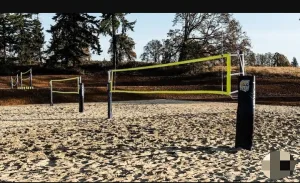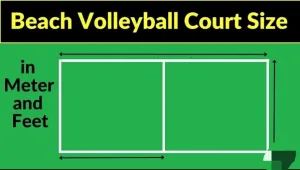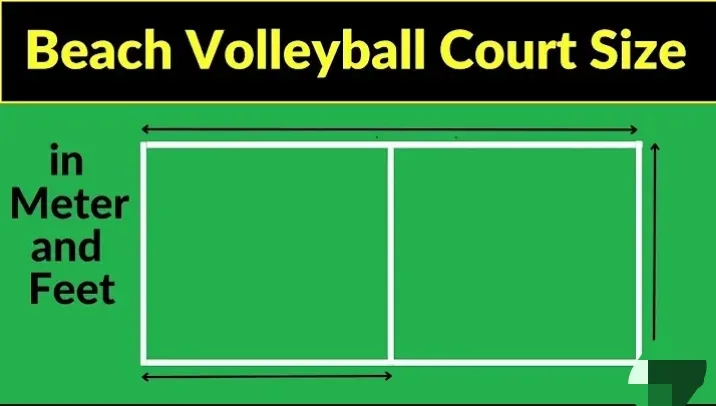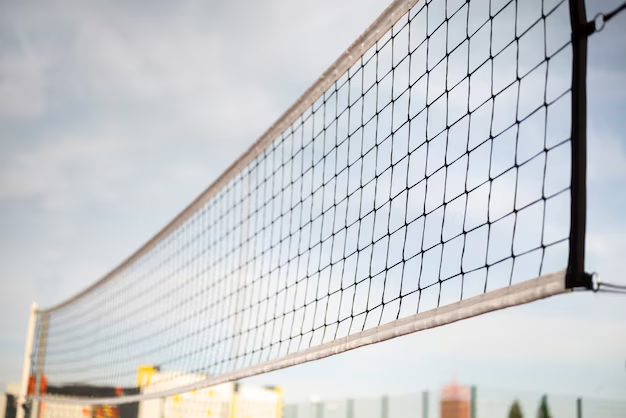The beach volleyball court dimensions parameters used in official matches are set by the FIVB (International Volleyball Federation) and have not changed since 2001.
Beach volleyball is more than just a summer activity—it’s a popular and exciting sport enjoyed worldwide. Whether you’re playing casually or training for a competition, understanding the beach volleyball court dimensions is key to ensuring a proper game. In this article, we’ll break down the official dimensions, explain how they differ from indoor volleyball court, and share tips for setting up your own court.
Standard Beach volleyball court dimensions

The beach volleyball court dimensions for official games are set by the FIVB (International Volleyball Federation). The court measures 16 meters in length and 8 meters in width, creating a rectangular playing area. Unlike indoor volleyball, where six players per team share the court, beach volleyball is typically played with two players on each side. The smaller court size and fewer players make for a fast-paced, exciting game.
When setting up a recreational court, these dimensions are flexible. For a backyard game or casual play, you can adjust the size of the court to fit your available space. However, keeping the general ratio close to 16×8 meters will help preserve the feel of an official match.
Net Height for Beach Volleyball
In addition to understanding court size, the height of the net is another essential factor. The official net height for men is 2.43 meters (7 feet 11 5/8 inches), while the height for women is slightly lower, at 2.24 meters (7 feet 4 1/8 inches).
For mixed-gender or junior play, these measurements can be adjusted based on the age and skill level of the participants. For example, for younger players, lowering the net allows for better rallies and more engaging gameplay.
Border lines and marking
The court’s boundary lines define the playing area and consist of two end lines and two sidelines. These lines are typically 5-8 cm wide and should contrast with the sand to ensure visibility.
In official games, the lines are marked using flexible tape anchored into the sand. However, for casual games, you can mark the boundaries using any visible material, such as string or rope. Ensuring the lines are easy to see will help players determine whether a ball is in or out during fast-paced rallies.
Sand Depth and Quality
A critical aspect of beach volleyball is the sand itself. The recommended sand depth for an official beach volleyball court is 30 to 40 centimeters. The sand should be fine enough to cushion falls but not so soft that it makes running and jumping difficult.
Sand texture plays a huge role in player safety and performance. Coarse sand can cause scrapes, while overly soft sand makes movement sluggish. Ideal beach volleyball sand is both fine and firm, giving players a stable surface to jump and dive without fear of injury.
Playing Zone Regulations
Beyond the court’s boundaries, a free playing zone is required for the safety of the players. This zone should be at least 5 meters wide on each side of the court and 7 meters above the playing surface. This ensures that players have enough room to dive for the ball without running into obstacles like fences, benches, or spectators.
Setting Up a Beach Volleyball Court at Home
Setting up your own beach volleyball court can be a fun project! To recreate the official dimensions at home, you’ll need a 16×8-meter space. Make sure you have a solid net, boundary lines, and, most importantly, quality sand. If you don’t have access to professional-grade sand, playground sand can be a good alternative. Just ensure it’s clean and free from rocks.
For recreational setups, the court size can be flexible. Even if you reduce the size slightly, sticking to the 2:1 length-to-width ratio will give your court the same feel as an official one.
See Also: Beach Volleyball Rules
Beach volleyball court dimensions for casual play
While official beach volleyball court dimensions are used in professional games, many casual players set up smaller courts to fit their needs. For example, in a backyard game, the court might be reduced to 12 meters long and 6 meters wide, allowing for more space around the court for spectators or other activities.
Adjusting the dimensions for fun play doesn’t take away from the excitement of the game. Just remember, the key is making sure the court is comfortable for both teams and that everyone has enough room to play their best.
See Also: Beach Volleyball vs Indoor Volleyball: Similarities and Differences
Beach volleyball court dimensions – Keys takeaway

Beach volleyball court dimensions in meters
The official beach volleyball court dimensions in meters are:
- Length: 16 meters
- Width: 8 meters
These dimensions are consistent for both men’s and women’s tournaments, including the Olympics and FIVB competitions. The court is divided evenly by the net, with each team occupying one side of the 8×8-meter space.
Beach volleyball court dimensions in feet
For those more familiar with the imperial system, the beach volleyball court dimensions in feet are:
- Length: 52 feet, 6 inches
- Width: 26 feet, 3 inches
These dimensions create the same court size as the metric measurements, ensuring fair play regardless of the system used.
2-Man Beach Volleyball Court Dimensions
In most cases, beach volleyball is played in a 2-man format, meaning two players per team. The 2-man beach volleyball court dimensions are the same as the standard beach volleyball court, 16 meters by 8 meters (52.5 x 26.25 feet). This smaller team size, paired with the compact court, creates a dynamic game that requires agility, endurance, and teamwork.
The two-player format is what you’ll see in professional leagues like the AVP (Association of Volleyball Professionals) and during the Olympic Games.
Olympic Beach volleyball court dimensions
The Olympic beach volleyball court dimensions are the same as those in other official competitions. They are:
- Length: 16 meters
- Width: 8 meters
During the Olympics, the court is set up with strict adherence to these dimensions, along with additional requirements like proper sand quality, boundary markings, and free space for play. The court is designed to accommodate both men’s and women’s competitions.
FAQs About Beach Volleyball Court Dimensions
1. What are the official beach volleyball court dimensions?
The official beach volleyball court dimensions are 16 meters long and 8 meters wide. These measurements are used in professional tournaments and set the standard for beach volleyball courts worldwide.
2. Can I make the court smaller for casual play?
Yes! Many people adjust the court size for casual games. For example, you could use a 12×6-meter space for backyard games. As long as both teams agree on the size, you can customize the court to fit your available space.
3. How deep should the sand be for a beach volleyball court?
The recommended sand depth for a beach volleyball court is between 30 and 40 centimeters. This provides enough cushion to prevent injuries while allowing players to move freely.
4. What is the height of a beach volleyball net?
For men, the official net height is 2.43 meters (7 feet 11 5/8 inches), and for women, it’s 2.24 meters (7 feet 4 1/8 inches). These heights can be adjusted for junior or mixed-gender play to suit the players’ skill levels.
5. What type of sand should I use for my beach volleyball court?
The best sand for a beach volleyball court is fine and firm, without large rocks or debris. You can use specialized beach volleyball sand or clean, sifted playground sand to ensure safety and performance during play.
By following the official beach volleyball court dimensions or adapting them for casual use, you can enjoy this dynamic sport whether you’re on a professional court or playing with friends at the beach!




